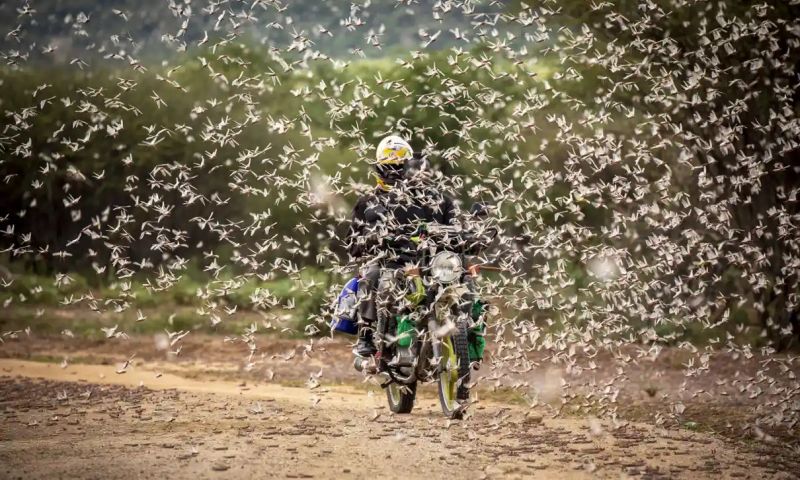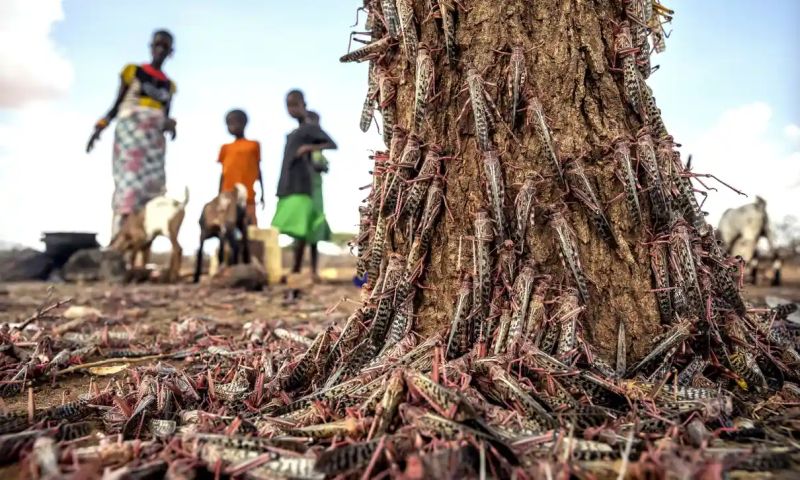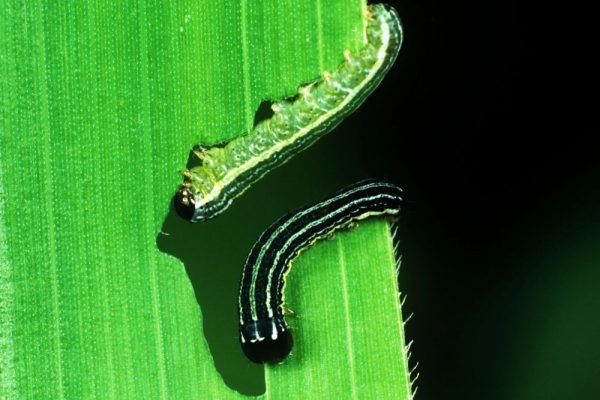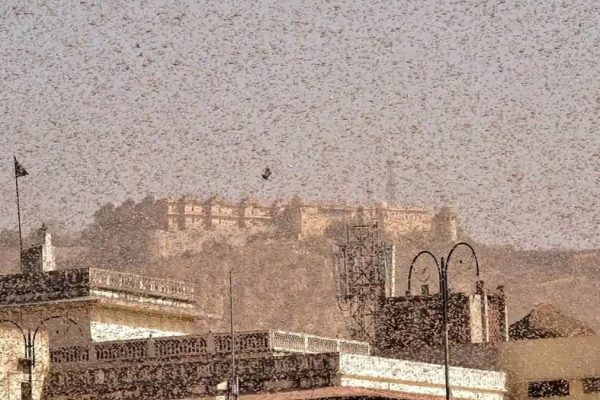Locust Swarms Threaten Crops in African and South Asian Countries
While the whole world is grappling with COVID-19 pandemic, another problem for African and south-Asian countries has raised its head. Swarms of locusts are ravaging the African lands and now it is certain that these locust swarms are set to invade Sindh after May 15.

A swarm of desert locusts in Kipsing, near Oldonyiro, in Isiolo County, Kenya on 31 March | Image: Sven Torfinn/FAO
Last year, the migratory pest emerged in January 2019 from eastern Africa and travelled through Saudi Arabia and Iran to enter Pakistan, where they invaded the cotton-producing belt of the Sindh province. The adult locusts then flew into the Indian side of the Thar desert, damaging the crops in western Rajasthan and northern Gujarat.
Although these migratory pest are usually harmful, under suitable circumstances of drought followed by rapid vegetation growth, they start to breed abundantly, becoming gregarious and nomadic. These swarms move around and rapidly strip fields and cause damage to crops.
Invading South-Asian Countries
This plague could destroy agriculture not only in Sindh but in other parts of the country by demolishing crops as well. This could even weaken Pakistan’ s economy further and trigger a food crisis in the country.
During the 41st Desert Locust Control Committee (DLCC) meeting of the UN’s Food and Agriculture Organization (FAO) in Addis Ababa in December 2019, it was stated by the Iranian representative that the level of invasion in Iran in 2019 was the highest in 50 years. It roughly predicts the impending disaster that will fall upon Pakistan.
The looming locust invasion may lead to appalling economic hardships. The existing supply chain uncertainty, market chaos, lockdowns, panic buying, scarcity of food items and trade disruptions have already created a panicky atmosphere.
The locust infestation could create more issues with the food supply process. As it is quite evident, the food supply mechanism involves an intricate mixture of producers, transporters, middlemen, static and mobile markets, market managers and consumers.

Desert locusts in Kipsing, near Oldonyiro, in Isiolo county, Kenya | Image: Sven Torfinn/FAO
Presently, Pakistan’s Department of Plant Protection (DPP), a wing of the Ministry of National Food Security and Research, is tasked with locust control. However, the situation on the ground and the grand size of the task specify that the department is too small and ill-prepared to tackle the issue.
In India, scientists at Punjab Agricultural University (PAU) have warned the farmers against a possible desert locust attack in the border areas of Punjab and Rajasthan. The warning was issued after locust sightings in Fazilka, and considering the continuous breeding activity of locusts in the Middle East and Pakistan.
Entomology department head PK Chhuneja said that in the last couple of weeks, small groups of hoppers had been witnessed in some areas of Rajasthan and Punjab.
He further added,
These locusts are sneaking into India from Pakistan. They are likely to arrive in swarm and damage the vegetation in the border areas of Rajasthan and Punjab.
He said that the swarms of locusts invaded India during monsoon. However, they appeared in January and February this year owing to the climate changes.
Rajasthan Chief Minister Ashok Gehlot drew Prime Minister Narendra Modi’s attention to the massive attack of locusts, starting from border with Pakistan, in several districts and sought the Centre’s help in dealing with the problem.
Mr. Gehlot said that the attack which had started in the Thar desert in May 2019 had extensively damaged crops and vegetation in 12 districts. This year, the tropical grasshoppers have started attacking agricultural fields from April 11.
Threatening African Food Supply
Amid the coronavirus crisis, Kenya is also bearing the brunt of deadly floods and the second wave of locust that threatens the country’s food supply. A locust swarm of deadly proportions is expected to ravage Kenya via Ethiopia for the second time this year.
The first swarm of migratory pest was the largest that east Africa has seen in over 30 years and the worst Kenya had witnessed in 70 years.
The first-generation swarm peaked in the region two months ago, with numbers multiplying rapidly. Second-generation swarm is considered even bigger and more threatening.
Authorities and the U.N. have warned that the locust will lead to major food shortages in the region. Recently, the U.N said that the situation was “extremely alarming” as an increasing number of new swarms from in north and central Kenya, Ethiopia and Somalia.
Presently, there are 18 swarms in Kenya. Regional governments have asked for financial help to combat swarms, but it is a low priority due to the pandemic. It is not easy to manage and control the swarms, especially without proper gear.
Ambroke Ngetich, FAO Project Officer in Kenya, said,
Every time you are trying to control in one region, there is another swarm that is happening in a different region and it is not possible to control them simultaneously.
Ten of thousands of liters of pesticides have been unable to reach the region owing to the coronavirus lockdowns and disrupted supply chains. Masses of adequate protective gear, to be used while spraying the pesticides, have also no reached the region.
David Hughes from the U.N.’s FAO, said,
The swarms threaten the food of 23 million people. It is the number one food security issue in East Africa at the moment…When you add on the top of it, cyclones or whatever else we’ll have in the next 2-3 months…It’s an absolutely unmitigated disaster.
The FAO has warned that it will be too late to the locusts from spreading in less than six months, which would simply threaten millions with starvation.
So far, the winds have kept the swarm in northern Kenya and southern Ethiopia, which contains lots of open lands unused by farmers. However, while millions in the region are depending on food aid, this could easily turn into a humanitarian crisis.
The desert locust situation update report by FAO says,
The current situation in East Africa remains extremely alarming as more swarms form and mature in northern and central Kenya and southern Ethiopia. This represents an unprecedented threat to food security and livelihoods because it coincides with the early beginning of the long rains and the current growing season.
The swarms are a threat to the entire East Africa region, not just Kenya. In February, eight east African countries experienced the worst outbreak in 70 years, exacerbated by climate change and war in Yemen. Yemen and east Africa are roughly 152 miles apart, separated just by the Gulf of Aden. Ethiopia, Kenya and Uganda were worst hit by the swarms.
Meanwhile, Somalia has declared a national emergency as large swarms of migratory pest spread across east Africa. The country’s Ministry of Agriculture said the insects, which consume large amounts of vegetation, posed “a major threat to Somalia’s fragile food security situation”.
There are fears that the situation may not be brought under control before the harvest begins in April. The U.N. says the swarms are the largest in Somalia and Ethiopia in 25 years and this plague could bring major starvation issues in the region.

